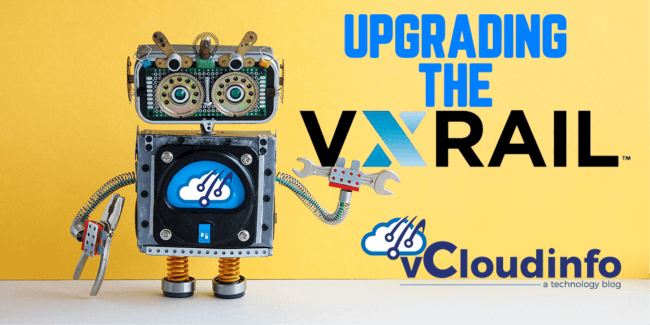Upgrading VXrail 4.7.5xx to 7.0.x

Today I am upgrading a customer VXRail environment. The 4.7 platform is almost End Of Life so it’s important to upgrade before there are any issues with support. Upgrading the clusters and keeping them well maintained in terms of versions is a critical step in operational readiness. Many times, without proper patching, support becomes a never-ending finger-pointing exercise as to why software is not working as intended. The longer you wait to upgrade and the larger the gap between versions also can exasperate any issues you may encounter during the upgrade.
The process of upgrading a VXRail is pretty straightforward. There is a clean wizard built within vCenter management. There are a couple of different ways to get the upgrade package but my favorite and the easiest is the Internet Update. Clicking update will instruct the system to fetch the latest upgrade package from the Dell/EMC website.

It is also advisable to first run the Pre-Check to see if there are any issues you have to remediate before beginning the upgrade process.
My first go at upgrading yielded the following vCenter incompatibility issue.

Looks like this error relates to vCenter being Customer Managed. This means that we as the customer will have to upgrade it manually prior to the VXrail upgrades. You can see if it is VXRail managed if you have the ability to Convert the vCenter Mode like in the image below.

If you don’t see this in the VXRail About screen, you have a Customer Managed vCenter that will need to be upgraded manually.
Upgrading vCenter
For a good walk-through of that process, check out Mike’s post here.
https://miketabor.com/how-to-upgrade-vcenter-server-appliance-6-7-to-7-0/
I did run into a few slight annoyances with the upgrade though – Both had to do with our use of Distributed Virtual Switches.
When upgrading the vCenter, I would have typically pointed the destination to an ESXi host. Since ESXi hosts can’t see the DVS, I had to point the destination to the source vCenter which feels very counterintuitive but worked just fine.
The second issue was related to the LACP feature that was deprecated in 6.7. We just needed to upgrade the DVS and the upgrade went through without any further hitches.

Once the vCenter is upgraded, don’t forget to put the new 7.x licenses on it before moving back to the VXRail Upgrade wizard.
Upgrading VXRail
The upgrade process for the VxRail (once all the prerequisites are met) goes pretty easy. The system is orchestrated in a way that it handles most things in an orderly fashion, moving VMs on and off the systems as they are upgraded and restarted.
Occasional issues can crop up when you have VMs that prevent the ESXi Hosts from going into Maintenance mode. Easy ones to fix are checking your VMs to make sure there are no connected ISOs that will prevent them from vMotioning off. Other trickier ones like replicas and such can be fixed by turning them off and then moving them manually. I like to watch the first few hosts go into Maintenance mode to address any of these problems live and keep the upgrade moving smoothly. If not, the upgrade will usually time out, present an error that you can then resolve manually, and then restart the upgrade process.

Last ditch efforts to fix a stalled upgrade are to reboot the VXRail Management VM, Reboot ESXi nodes, manually put them into Maintenance mode, and eventually restart vCenter.
Happy Upgrading!
– Carlo

